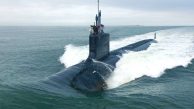
Expansion of Navy’s Surface Combat Fleet on Horizon
Photo: HMAS Stalwart conducts a dual replenishment at sea with HMA Ships Toowoomba and Brisbane during an Asian regional presence deployment. Photo by Leading Seaman Daniel Goodman.
The Government has unveiled its strategic vision for the future of the Royal Australian Navy’s surface combatant fleet, steering clear of partisan rhetoric in its announcement. This unveiling comes after a thorough evaluation of an independent analysis commissioned in response to the Defence Strategic Review.
Defence Minister Richard Marles, stressed the imperative for a larger and more potent surface combatant fleet in light of Australia’s evolving strategic landscape. He emphasized the necessity for bolstered maritime security to safeguard sea lanes and trade routes, especially within the immediate regional context.
According to Mr. Marles, the forthcoming fleet will mark a significant milestone, constituting the largest assembly of surface combatants since World War II. The independent analysis underscored the pressing need for immediate enhancements across various naval capabilities, including air defence, long-range strike, presence, and anti-submarine warfare.
Outlined within the blueprint are plans for the future surface combatant fleet, which includes:
- Three Hobart-class air warfare destroyers, slated for upgrades with the latest US Navy Aegis combat system.
- Six Hunter-class frigates, aimed at augmenting undersea warfare and strike capabilities, albeit three fewer than previous plans.
- Eleven new general-purpose frigates, designed to fulfill maritime and land-strike, air-defence, and escort roles.
- Six new large, optionally crewed surface vessels (LOSVs), promising a substantial boost to long-range strike capacity—a deviation from earlier proposals.
- Decommissioning of the two oldest Anzac-class frigates, with the remaining six set for upgrades to enhance maritime strike capabilities.
In total, the fleet expansion plan outlines a procurement of 26 major surface combatants, a significant increase compared to prior projections. Additionally, the government has embraced recommendations for the acquisition of 25 minor war vessels, contributing to civil maritime security operations, including six offshore patrol vessels (OPVs).
The construction of Hunter-class frigates will take place at the Osborne shipyard in South Australia, followed by the replacement of Hobart-class destroyers. Moreover, plans include the consolidation of the Henderson precinct, as advised by the Defence Strategic Review, to facilitate the construction of eight new general-purpose frigates and pave the way for six new LOSVs in Western Australia.
To fund these endeavours, the government has committed an additional $1.7 billion over the Forward Estimates and $11.1 billion over the next decade in Defence expenditure, aiming for an accelerated delivery of the future surface combatant fleet and bolstering the Australian shipbuilding industry. This commitment supplements the previously allocated $30.5 billion to Defence’s Integrated Investment Program, extending to 2032-33.
Minister Marles reiterated that the envisaged surface combatant fleet, characterized by enhanced lethality, would align with Australia’s strategic imperatives, as endorsed by the Independent Analysis Team’s rigorous assessment. He stressed the critical role of the Royal Australian Navy in ensuring the safety and security of vital sea lanes and trade routes, fundamental to national prosperity and connectivity.
Echoing these sentiments, Minister for Defence Industry Pat Conroy emphasized the symbiotic relationship between a robust naval capability and a sovereign defence industry, highlighting the plan’s significance in fortifying both.
Chief of Navy Vice Admiral Mark Hammond underscored the importance of a strong naval force in advancing Australia’s diplomatic interests, deterring potential threats, and safeguarding national interests. He expressed confidence that the future surface combatant fleet’s size, lethality, and capabilities would position the navy to address evolving regional challenges effectively.
In closing, the government extended gratitude to Vice Admiral William Hilarides, USN (Retd), Rosemary Huxtable, and Vice Admiral Stuart Mayer for their leadership in the independent analysis, which has facilitated the most comprehensive update to the Navy’s fleet in decades.



